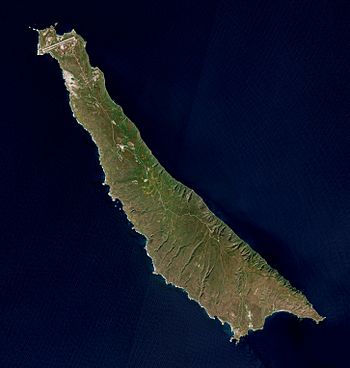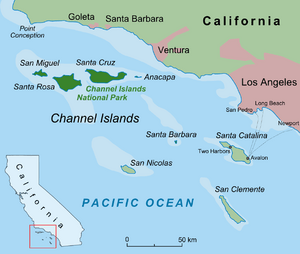San Clemente Island facts for kids
 |
|
| Geography | |
| Location | Pacific Ocean |
| Coordinates | 32°54′N 118°30′W / 32.900°N 118.500°W |
| Archipelago | Channel Islands (California) |
| Administration | |
| State | |
| County | Los Angeles |
San Clemente Island is the most southern island in the Channel Islands of California. Its name in the Tongva language is Kinkipar. In Spanish, it is called Isla de San Clemente.
The United States Navy owns and manages the island. It is part of Los Angeles County. The island is about 21 miles (34 km) long. It covers an area of 147.13 square kilometers (56.81 sq mi). In 2018, about 148 military and civilian people lived there. The city of San Clemente in Orange County is named after the island.
Contents
Island Geography
Island Shape and Land Features
San Clemente Island is like the top part of a tilted block of the earth's crust. It has a steep side facing northeast and a gentler slope on its southwest side. The island is mostly made of volcanic rock. A large fault line runs along the northeast side. This fault is similar to others on the California mainland.
The island has amazing examples of marine terraces. These are flat areas formed by ocean waves over time. You can also find deep, trench-like canyons, streams, and even waterfalls that appear sometimes. There are also pools of fresh water.
The highest point on the island is Mount Thirst. It stands at 1,965 feet (599 meters) high. The island's ridge can affect the weather. It can make moisture in the air turn into rain. This was a reason for a heavy rainstorm in San Diego on January 22, 2024.
Island Climate
San Clemente Island has warm, dry summers. Its fall and winter seasons are mild. The average monthly temperature never goes above 21 °C (69.5 °F). This type of weather is called a warm-summer Mediterranean climate. On climate maps, it is known as "Csb."
| Climate data for San Clemente Island, CA (normals and extremes 1963-1989) | |||||||||||||
|---|---|---|---|---|---|---|---|---|---|---|---|---|---|
| Month | Jan | Feb | Mar | Apr | May | Jun | Jul | Aug | Sep | Oct | Nov | Dec | Year |
| Record high °F (°C) | 84.0 (28.9) |
80.1 (26.7) |
87.1 (30.6) |
88.0 (31.1) |
93.9 (34.4) |
100.9 (38.3) |
86.0 (30.0) |
84.9 (29.4) |
102.0 (38.9) |
93.9 (34.4) |
90.0 (32.2) |
79.0 (26.1) |
102.0 (38.9) |
| Mean daily maximum °F (°C) | 65 (18) |
64 (18) |
65 (18) |
68 (20) |
69 (21) |
71 (22) |
74 (23) |
75 (24) |
75 (24) |
73 (23) |
68 (20) |
65 (18) |
69 (21) |
| Mean daily minimum °F (°C) | 49 (9) |
50 (10) |
52 (11) |
54 (12) |
57 (14) |
60 (16) |
62 (17) |
64 (18) |
63 (17) |
59 (15) |
53 (12) |
49 (9) |
56 (13) |
| Record low °F (°C) | 36.0 (2.2) |
39.9 (4.4) |
39.0 (3.9) |
42.1 (5.6) |
44.1 (6.7) |
52.0 (11.1) |
52.0 (11.1) |
55.0 (12.8) |
52.0 (11.1) |
44.1 (6.7) |
41.0 (5.0) |
37.9 (3.3) |
36.0 (2.2) |
| Average precipitation days (≥ 1.0 mm (0.039 inches)) | 4.7 | 3.8 | 4.3 | 2.4 | 0.6 | 0.1 | 0.2 | 0.2 | 0.8 | 0.9 | 3.2 | 3.6 | 24.8 |
| Average relative humidity (%) (at 10 PT) | 71.4 | 74.1 | 73 | 68.9 | 71.9 | 74.1 | 75.9 | 74.9 | 74.5 | 71.9 | 71.4 | 72.7 | 72.9 |
| Average dew point °F (°C) | 47.7 (8.7) |
49.3 (9.6) |
49.5 (9.7) |
49.5 (9.7) |
51.8 (11.0) |
55.0 (12.8) |
57.9 (14.4) |
59.5 (15.3) |
58.8 (14.9) |
56.1 (13.4) |
52.3 (11.3) |
49.3 (9.6) |
53.1 (11.7) |
| Source 1: NOAA (all data except mean daily max/min) | |||||||||||||
| Source 2: Weather.com: | |||||||||||||
Island Wildlife and Plants
Animals of San Clemente Island
The San Clemente Island loggerhead shrike is an endangered species. This means it is at risk of disappearing forever. The Navy is working hard to protect these birds. The San Clemente Island fox is a type of fox found only on this island.
For hundreds of years, wild goats roamed the island. By 1972, there were 11,000 goats. Scientists realized they were harming the plants and animals that naturally live there. By 1980, the number of goats was reduced to 4,000. Later, all the goats were removed using nets and helicopters. The San Clemente Island goat is now a special breed of domestic goat.

The ocean around the island is full of amazing marine life. People who go snorkeling can see sea lions, spiny lobsters, and colorful hydrocoral. There are also large kelp forests underwater.
The island is also home to the endangered San Clemente Island sage sparrow. For many years, raptors (birds that hunt) did not breed here. This was due to pollution and Navy activities. Now, at least one pair of bald eagles and several pairs of peregrine falcons are breeding on the island.
Plants of San Clemente Island
The island has about 300 types of native plants. It also has about 135 types of plants that are not native. At least 47 native plant types are found on two or more of the California Islands. Fifteen plant types are found only on San Clemente Island. One plant type unique to the island is thought to be extinct.
The island's plants include some species found nowhere else in the world. These unique plants are called endemic species. They include wildflowers like the San Clemente Island brodiaea and San Clemente Island triteleia. Other unique plants are the San Clemente Island woodland star and San Clemente Island Indian paintbrush. There are also special shrubs like the San Clemente Island bushmallow and Blair's wirelettuce. A special type of toyon plant, called ssp. macrocarpa, also grows here. Two rare types of the royal larkspur are also found.
In 2008, Earthworms were likely brought to the island. They came in soil used for a road project. Earthworms are not native to this area. They change the soil and tiny living things in it. This allows non-native plants to grow more easily. These changes can harm the island's special ecosystem and its many different kinds of life.
Island History
Archaeologists have found signs that people lived on San Clemente Island as far back as 10,000 years ago.
Later people who lived there traded goods from other islands and the mainland. This included Coso obsidian, a type of volcanic glass, from the California desert. We don't know for sure which tribe these later people belonged to. However, the Tongva, who lived on nearby Santa Catalina Island, are the most likely group. The Chumash people, who lived on the northern Channel Islands, might have also influenced the island's inhabitants.
The first European to see the island was Juan Rodríguez Cabrillo in 1542. He named it Victoria. Later, Spanish explorer Sebastián Vizcaíno renamed it. He saw the island on November 23, 1602, which is Saint Clement's feast day. For many years in the 1800s and early 1900s, ranchers, fishermen, and smugglers used the island.
In 1835, the whaleship Elbe hunted sperm whales near "St. Clements Island." Later, in the 1920s and 1930s, ships like the Lansing and California anchored in Pyramid Cove. They processed large whales like blue, fin, and humpback whales caught by smaller boats. In 1935, a Norwegian factory ship called Esperanza also caught blue whales near the island.
The United States Navy took over the island in 1934. It is the Navy's only place where they can practice live firing from ships to the shore. The island is also the center of a large training area called the San Clemente Island Range Complex. This area covers 2,620 square nautical miles (8,990 km2) of air, land, and sea.
During World War II, the Navy used the island to train with amphibious landing craft. These were small and medium-sized boats. They were very important for moving troops and equipment from ships to shore. This training helped during the "island hopping" strategy used to attack Japanese-held islands.
The island also has an active sonar base. Sonar uses sound waves to detect objects underwater. There is also a $21 million fake city used for commando training.
The US Navy has a rocket-test facility on San Clemente. Some test rockets for the Polaris program were launched from here between 1957 and 1960. The SEALAB III project, which studied underwater living, took place off San Clemente in February 1969.
The US Navy uses the island as an extra naval airfield. It is called Naval Auxiliary Landing Field San Clemente Island. The main runway is used for carrier training by the Navy. Other military groups, like the United States Coast Guard, also use this airfield.
As of 2014, San Clemente is home to an extra Air Force base. This base helps find Air Force fighter pilots near the California coast. The island is also used for training by the United States Navy SEALs.
On July 30, 2020, an accident happened during a training exercise. An amphibious assault vehicle (AAV) sank off the island's northwest coast. Seven Marines and one Navy sailor were believed to have died. One of eight Marines rescued from the vehicle also died later. The names of all nine people who died were shared on August 3. Fifteen Marines and a sailor were on the AAV when it was returning to the USS Somerset.
On August 3, 2020, the USMC announced that the AAV had been found. The vehicle sank in almost 400 feet (122 meters) of water.
Another accident happened on August 27, 2020. Two soldiers died and three were hurt when their Black Hawk helicopter crashed on San Clemente Island.
Images for kids
-
Swellshark, San Clemente Island
See also
 In Spanish: Isla San Clemente para niños
In Spanish: Isla San Clemente para niños
















